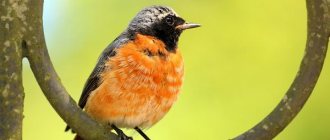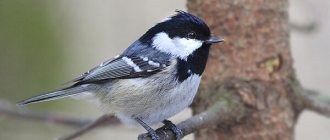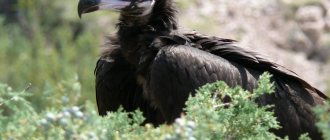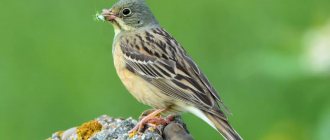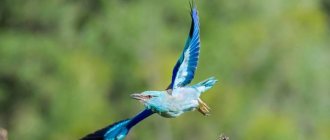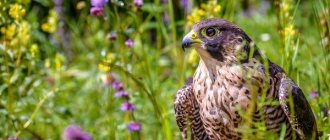| Latin name: | Phoenicurus |
| English name: | Redstart |
| Kingdom: | Animals |
| Type: | Chordata |
| Class: | Birds |
| Squad: | Passeriformes |
| Family: | Flycatchers |
| Genus: | Redstarts |
| Body length: | 10-15 cm |
| Wing length: | 8 cm |
| Wingspan: | 25 cm |
| Weight: | 25 g |
- 2.1 Black Redstart
Description of the bird
The size of the redstart is 10-15 cm, but the wingspan at full swing reaches 25 cm. Body weight does not exceed 20 grams.
What does it look like
The redstart can be easily recognized; it is a small bird with a red tail . A distinctive feature of the redstart is the color of the tail and abdomen; they are rich red, the back is gray. Despite this, females are browner in color. During the flight from branch to branch, the redstart characteristically twitches its tail, which seems to flare up with a bright fire in the sun's rays, after which it freezes. The redstart was so named because of the rich color of the tail, it seems to be “burning” (The tail is burning).
Kinds
— Advertising —
Among the redstarts, there are several different species, which include: gray-headed redstart (common), black redstart, Siberian redstart, red-bellied redstart, coot redstart, garden redstart. At the same time, they are all distinguished by a slender physique, an awl-shaped beak with a small one at the end, and long and thin legs.
Redstart
The black redstart or black redstart is often found in Europe and central Asia.
It is smaller than a sparrow and weighs 14-19 grams. The male has dark gray upper plumage; forehead, frenulum, cheeks, neck and crop black; the tail is rusty orange with black speckles. At the same time, the female has a uniform grayish-brown tint, with the exception of the red uppertail and light red undertail. The following birds live in mountain landscapes:
- rocky niches
- on the ledges of cliffs
- on slopes with a scattering of pebbles
They are also found in populated areas, where they are most often located in industrial and construction zones, open areas with individual buildings such as factory chimneys or church domes. Black redstarts live alone and in pairs.
— Advertising —
In Ukraine, the black redstart is considered a nesting, migratory bird species that is found throughout the country.
The singing is very primitive and rough with hoarse elements, like that of wheatears. At the beginning, a short hoarse trill is heard, the volume of which gradually increases, and after that a rough, long trill is formed. In black redstarts, the melody can be repeated several times in a row.
Grey-headed or common redstart
The Grey-headed or Common Redstart is one of the beautiful birds.
However, only the male can boast of luxuriously colored plumage, because the female’s plumage is poorer. The color is brown, but the tail is bright red. The male has an ash-gray back plumage, his chest, belly, sides and tail are painted in a rusty-red hue, but his throat and cheeks are black. Also sometimes the male has a white forehead. The common redstart lives in northwestern Africa, Eurasia and most of Russia.
Despite the external differences, the common redstart is also distinguished by its sonorous singing. At the beginning, the trill is frequent and sonorous, but over time the frequency of the trill decreases.
Garden redstart
The garden redstart prefers to build nests only in trees, which are located in old orchards and parks.
At the same time, he prefers to live away from people. The garden redstart is also found in tall mixed forests and coniferous forests, where there are always dense shrubs. The male garden redstart has an ash-gray upper body and a black throat, sides and forehead. In addition, the upper part of the head and the middle of the lower part of the body are white. The chest, sides and tail are bright rusty red. Unlike males, females are dark gray in color, but the lower part of the body is gray. The gray feathers of the lower body are also edged with rusty yellow.
The singing of the garden redstart is euphonious and rich. The singing contains melodic and gentle stanzas. Despite this, the redstart is a wonderful and shameless mockingbird, so it often interprets other people's songs.
Redstart Coot
The coot redstart is a small, slender bird on high, thin legs.
These are very active birds, so they fly from place to place all day, twitching their charming tail. The singing of the coot redstart differs from others. The song consists of a short, somewhat nasal trill, which begins with an extended sound and ends with a call that is sharply different from the middle of the song.
Siberian redstart
The Siberian redstart is found in light forests, bushes, gardens and even some villages in the south of Siberia, the Amur region and the Prigorye region.
In this case, nests are built in hollows, rock cracks, piles of stones or under the roof of buildings. The male Siberian redstart has a light gray color on the top of the head and neck, the sides of the head, throat, back and wings are black, but there is a white spot on the wings. The belly and tail are bright red. The female is similar to the female common redstart. Her plumage is brown, but her tail, like that of the male, is bright red. In addition, she also has a white spot on her wings.
Red-bellied Redstart
The Red-bellied Redstart is very similar to the Siberian Redstart, but is larger and more brightly colored.
The male has a reddish-brown chest, but the female has a reddish abdomen and no white spot on the wings. It lives in the highlands of the Central Caucasus and Southern Siberia, but winters in the lowlands - in sea buckthorn thickets or floodplain willows.
Lifestyle and habitat
The range of the redstart is wide, extending across the territory of North-West Africa, Asia and Europe. The birds spend the winter in the south of their range, and with the arrival of spring they return to Europe. The arrival of birds depends on warming and the appearance of a food supply - the abundance of insects in gardens, parks, and forest areas.
Redstarts avoid sparse areas; their appearance in the forest-steppe is unlikely. Their favorite places are old parks with hollow trees. The urban bird population often outnumbers the forest population.
The redstart prefers a solitary existence, so the birds stay separate from each other. Groups are formed only when food accumulates in one place. Each redstart occupies an individual area.
Until July you can hear their melodic singing, especially at night. Young males sing more than others. Their singing lasts almost around the clock. Later the birds become quiet. Late July - early August is the molting season for redstarts. With the arrival of autumn, birds fly away for the winter to the southern zones of their range - African countries, the Arabian Peninsula.
Observations of redstarts show that they like to nest in gardens in specially prepared houses on tall trees. Males arrive first to take place and show the arriving females their readiness to meet.
Bright tails, like beacons, lure the couple to the nesting site. This attraction of birds by gardeners is of great benefit. The future harvest is protected from insect pests: caterpillars, mosquitoes, leaf beetles. Birds are not embarrassed by their proximity to humans.
Spreading
The redstart is a typical European bird species, so its distribution area is quite diverse. Found in Europe, most of Western and Central Siberia and Western Asia. They mainly prefer to settle in pine forests. However, the main nesting sites are still forest edges, stumps in clearings, old groves, gardens and parks. In addition, redstarts prefer to nest in shelters where nests are safely erected. Nests are made in hollows, on thick tree branches, in dense bushes and old stumps.
Nutrition
The diet of redstarts, like all flycatcher birds, is based on insects. This feature makes birds undoubted protectors of forests, parks, and gardens. In one season, the redstart destroys a countless number of different beetles, ants, bedbugs, dung beetles, flies, mosquitoes, and their larvae. Birds usually hunt in flight, swallowing flying insects in the air. Catching prey in flight is more typical for males.
Female redstarts prefer to stalk ground food from higher elevations, settling on the lower branches of plants and niches of buildings. Having noticed prey, birds dive to the surface of the earth for spiders, earthworms, centipedes, snails, and caterpillars.
The food supply of redstarts is very diverse. At the end of summer, plant foods are added to the diet. Birds feast on wild and garden berries and plant seeds. It has been noticed that they love elderberries, currants, and raspberries.
The process of searching for food and eating it is interesting. Birds inspect trunks, cracks, watch the movement of branches and leaves. The caught prey is not immediately consumed, but is transported to a safe place for a meal.
The redstart deals with large insects in stages. First it stuns with its beak and throws it from a height to immobilize its prey. Then he cuts it into pieces. In small grasshoppers and running insects, the legs are pinched off before being eaten.
Redstarts are very careful when feeding their young. With their beaks, they first grind food to a mushy state, only then send processed berries or insects into the beaks of their heirs. The voracious chicks harass their parents to the point of physical exhaustion. Parents visit the nest up to 500 times a day, bringing crushed food in their beaks.
Reproduction
Most redstarts have a clutch of no more than 6-7 eggs, which are colored bright blue. The eggs are incubated exclusively by the female. After 2 weeks of incubation, the chicks are born, after which for another 2-3 weeks both parents bring food to the chicks. Chicks begin to fly a month after hatching. The chicks leave the nests after they grow up and learn to fly, but roam close to the nest. Young animals are located near ponds and in thickets of bushes. A distinctive feature of redstarts is that during the summer some pairs lay 2-3 clutches.
Redstart in the Red Book
With the advancement of technology, the population has declined sharply since about 1980. Expansion of construction in the habitats of species, the use of pesticides, and climate change in wintering areas leads to a decrease in numbers in some regions.
For example, if there are fewer redstarts in France and England, then the overall population in Europe has increased and is not classified as an endangered species.
The gray-headed redstart (Phoenicurus phoenicurus) is listed in the Red Book of Russia. Among the birds protected by the Red Book of the International Union for Conservation of Nature is the Angolan Redstart.
Many regions include birds living in their territories in the local Red Data Books. For example, the Tyumen region included the black redstart on the list of protected species, and in Tajikistan the gray redstart has a protected status.
Nesting
Nests are built in closed and inaccessible places.
At the same time, the nests are constructed in a careless manner and are cup-shaped. To build redstarts, they use a variety of dry stems of herbaceous plants, wood fibers mixed with leaves, moss and pieces of bark. After that, bedding is placed in the nest, consisting of wool, feathers and pieces of leaves. The dimensions of such a nest are small: diameter - 110 mm, height - 90 mm, tray diameter on average 90 mm, tray depth 40-70 mm. In addition, in the forests there are often special houses for redstarts, made by human hands. However, the house should be made only from high-quality material suitable for birds. It is best to use skipped boards for this - slab or edged, the thickness of which is 2-2.5 cm. In this case, the board should be planed only on the outside of the house.
It is better to make the house the optimal size:
- height - 20-25 cm
- bottom – 12 by 12
- the internal bottom area is 15-20 sq.cm
- patch diameter - 3-4 cm
- the distance from the bottom of the taphole to the bottom is 10-12 cm
- from the top of the taphole to the ceiling - 4-5 cm
It is also worth remembering that redstarts are partial to diamond-shaped houses, so you can attach them at an angle. In addition, in the summer the house is directed to the west or south, the main thing is not towards the wind.
Redstarts are also kept at home. They live well in cages. However, it is not recommended to keep several redstarts in one cage at once, because they fight, often until the death of their opponent.
Interesting Facts
- Redstarts sing around the clock, but are especially active in the morning and late evening.
- Often the redstart is also called the coot, kaluferka, and mountain redstart.
- Redstarts are similar to wagtails because they are like them. swing their tail up and down.
- The redstart got its name because of the color of its tail, which seems to be burning in the sun’s rays.
- Cuckoos often leave their eggs in the nest of redstarts, which take care of them as if they were their own.
- The male redstart hunts exclusively while flying, while the female searches for food on the ground.
